Coherent Dynamic Clutter Suppression in Structural Health Monitoring via the Image Plane Technique
Abstract
Highlights
- Dynamic clutter interferes with the received signal in Ground-based Interferometry.
- Through the Image plain technique the interference can be eliminated.
- Fast moving targets aliasing in doppler can be eliminated through the image plane technique.
- Fast moving target imaging can be performed as a by-product of the image plane technique.
Abstract
1. Introduction
2. Scenario and Problem Statement
2.1. Scenario
2.2. The Problem
3. Signal Model
4. Image Plane Technique
4.1. Rationale and Algorithm Description
4.2. Dynamic Clutter Imagery
4.3. Static Signal Focusing
4.4. Azimuth Ambiguities
4.5. Dynamic Clutter Suppression
4.6. Defocusing
4.7. Retrieval of Motion Parameters
4.8. Computational Complexity Analysis
5. Numerical Simulation
6. Real Data Results
6.1. First Case Study
6.2. Second Case Study
6.3. A Fortunate By-Product
7. Conclusions
Author Contributions
Funding
Informed Consent Statement
Data Availability Statement
Acknowledgments
Conflicts of Interest
Abbreviations
| SHM | Structural Health Monitoring |
| TDBP | Time Domain Backprojection |
| SAR | Synthetic Aperture Radar |
| InSAR | Synthetic Aperture Radar Interferometry |
| GBRI | Ground-Based Radar Interferometry |
| JCAS | Joint Communication and Sensing |
| PRF | Pulse Repetition Frequency |
| DoA | Direction of Arrival |
| SCR | Signal-to-Clutter Ratio |
| RMSE | Root Mean Square Error |
References
- Dong, Y.; Song, R.; Liu, H. Bridges Structural Health Monitoring and Deterioration Detection-Synthesis of Knowledge and Technology; Technical Report; University of Alaska Fairbanks: Fairbanks, AK, USA, 2010. [Google Scholar]
- Wenzel, H. Health Monitoring of Bridges; John Wiley & Sons: Hoboken, NJ, USA, 2008. [Google Scholar]
- Harms, T.; Sedigh, S.; Bastianini, F. Structural health monitoring of bridges using wireless sensor networks. IEEE Instrum. Meas. Mag. 2010, 13, 14–18. [Google Scholar] [CrossRef]
- Ferretti, A.; Savio, G.; Barzaghi, R.; Borghi, A.; Musazzi, S.; Novali, F.; Prati, C.; Rocca, F. Submillimeter accuracy of InSAR time series: Experimental validation. IEEE Trans. Geosci. Remote Sens. 2007, 45, 1142–1153. [Google Scholar] [CrossRef]
- Cusson, D.; Rossi, C.; Ozkan, I. Early warning system for the detection of unexpected bridge displacements from radar satellite data. J. Civ. Struct. Health Monit. 2021, 11, 189–204. [Google Scholar] [CrossRef]
- Gagliardi, V.; Tosti, F.; Bianchini Ciampoli, L.; Battagliere, M.L.; D’Amato, L.; Alani, A.M.; Benedetto, A. Satellite remote sensing and non-destructive testing methods for transport infrastructure monitoring: Advances, challenges and perspectives. Remote Sens. 2023, 15, 418. [Google Scholar] [CrossRef]
- Talledo, D.A.; Miano, A.; Bonano, M.; Di Carlo, F.; Lanari, R.; Manunta, M.; Meda, A.; Mele, A.; Prota, A.; Saetta, A.; et al. Satellite radar interferometry: Potential and limitations for structural assessment and monitoring. J. Build. Eng. 2022, 46, 103756. [Google Scholar] [CrossRef]
- Monti-Guarnieri, A.; Falcone, P.; d’Aria, D.; Giunta, G. 3D vibration estimation from ground-based radar. Remote Sens. 2018, 10, 1670. [Google Scholar] [CrossRef]
- Michel, C.; Keller, S. Advancing ground-based radar processing for bridge infrastructure monitoring. Sensors 2021, 21, 2172. [Google Scholar] [CrossRef] [PubMed]
- Luzi, G.; Pieraccini, M.; Mecatti, D.; Noferini, L.; Guidi, G.; Moia, F.; Atzeni, C. Ground-based radar interferometry for landslides monitoring: Atmospheric and instrumental decorrelation sources on experimental data. IEEE Trans. Geosci. Remote Sens. 2004, 42, 2454–2466. [Google Scholar] [CrossRef]
- Diaferio, M.; Fraddosio, A.; Piccioni, M.D.; Castellano, A.; Mangialardi, L.; Soria, L. Some issues in the structural health monitoring of a railway viaduct by ground based radar interferometry. In Proceedings of the 2017 IEEE Workshop on Environmental, Energy, and Structural Monitoring Systems (EESMS), Milan, Italy, 24–25 July 2017; pp. 1–6. [Google Scholar]
- Zhang, J.A.; Liu, F.; Masouros, C.; Heath, R.W.; Feng, Z.; Zheng, L.; Petropulu, A. An overview of signal processing techniques for joint communication and radar sensing. IEEE J. Sel. Top. Signal Process. 2021, 15, 1295–1315. [Google Scholar] [CrossRef]
- Liu, A.; Huang, Z.; Li, M.; Wan, Y.; Li, W.; Han, T.X.; Liu, C.; Du, R.; Tan, D.K.P.; Lu, J.; et al. A survey on fundamental limits of integrated sensing and communication. IEEE Commun. Surv. Tutor. 2022, 24, 994–1034. [Google Scholar] [CrossRef]
- Wei, Z.; Qu, H.; Wang, Y.; Yuan, X.; Wu, H.; Du, Y.; Han, K.; Zhang, N.; Feng, Z. Integrated sensing and communication signals toward 5G-A and 6G: A survey. IEEE Internet Things J. 2023, 10, 11068–11092. [Google Scholar] [CrossRef]
- González-Prelcic, N.; Tagliaferri, D.; Keskin, M.F.; Wymeersch, H.; Song, L. Six Integration Avenues for ISAC In 6G and Beyond: A Forward-Looking Vision. IEEE Veh. Technol. Mag. 2025, 20, 18–39. [Google Scholar] [CrossRef]
- Tan, D.K.P.; He, J.; Li, Y.; Bayesteh, A.; Chen, Y.; Zhu, P.; Tong, W. Integrated sensing and communication in 6G: Motivations, use cases, requirements, challenges and future directions. In Proceedings of the 2021 1st IEEE International Online Symposium on Joint Communications & Sensing (JC&S), Dresden, Germany, 23–24 February 2021; pp. 1–6. [Google Scholar]
- Santi, F.; Pisciottano, I.; Pastina, D.; Cristallini, D. Multi-angle DVB-S based passive ISAR sensitivity to target motion estimation errors. In Proceedings of the 2023 IEEE Radar Conference (RadarConf23), San Antonio, TX, USA, 1–5 May 2023; pp. 1–6. [Google Scholar]
- Colone, F.; Filippini, F.; Di Seglio, M.; Chetty, K. On the use of reciprocal filter against WiFi packets for passive radar. IEEE Trans. Aerosp. Electron. Syst. 2021, 58, 2746–2761. [Google Scholar] [CrossRef]
- Pieraccini, M.; Miccinesi, L. Ground-based radar interferometry: A bibliographic review. Remote Sens. 2019, 11, 1029. [Google Scholar] [CrossRef]
- Miao, C.; Zhang, W.; Qin, Z.; Wu, W. Fast distance and velocity estimation in parameter agility radar using CM-CS-OMP and CM-MUSIC methods. Digit. Signal Process. 2025, 157, 104915. [Google Scholar] [CrossRef]
- Liu, Z.; Li, D.; Guo, H.; Wang, X. Research on Radar Clutter Suppression Method Based on Stagger MTI. J. Phys. Conf. Ser. 2023, 2625, 012031. [Google Scholar] [CrossRef]
- Ferrari, A.; Berenguer, C.; Alengrin, G. Doppler ambiguity resolution using multiple PRF. IEEE Trans. Aerosp. Electron. Syst. 2002, 33, 738–751. [Google Scholar] [CrossRef]
- Curlander, J.C.; McDonough, R.N. Synthetic Aperture Radar; Wiley: New York, NY, USA, 1991; Volume 11. [Google Scholar]
- Hanssen, R.F. Radar Interferometry: Data Interpretation and Error Analysis; Springer Science & Business Media: Berlin, Germany, 2001; Volume 2. [Google Scholar]
- Guarnieri, A.M. Adaptive removal of azimuth ambiguities in SAR images. IEEE Trans. Geosci. Remote Sens. 2005, 43, 625–633. [Google Scholar] [CrossRef]
- Moreira, A. Suppressing the azimuth ambiguities in synthetic aperture radar images. IEEE Trans. Geosci. Remote Sens. 1993, 31, 885–895. [Google Scholar] [CrossRef]
- Polisano, M.G.; Manzoni, M.; Tebaldini, S. Synthetic Aperture Radar Processing Using Flexible and Seamless Factorized Back-Projection. Remote Sens. 2025, 17, 1046. [Google Scholar] [CrossRef]
- Wu, R.S.; Toksöz, M.N. Diffraction tomography and multisource holography applied to seismic imaging. Geophysics 1987, 52, 11–25. [Google Scholar] [CrossRef]
- Polisano, M.G.; Manzoni, M.; Tebaldin, S.; Monti-Guarnieri, A.V.; Prati, C.M.; Russo, I. Automotive MIMO-SAR Imaging from Non-continuous Radar Acquisitions. In Proceedings of the 2023 Photonics & Electromagnetics Research Symposium (PIERS), Prague, Czech Republic, 3–6 July 2023; pp. 578–587. [Google Scholar]
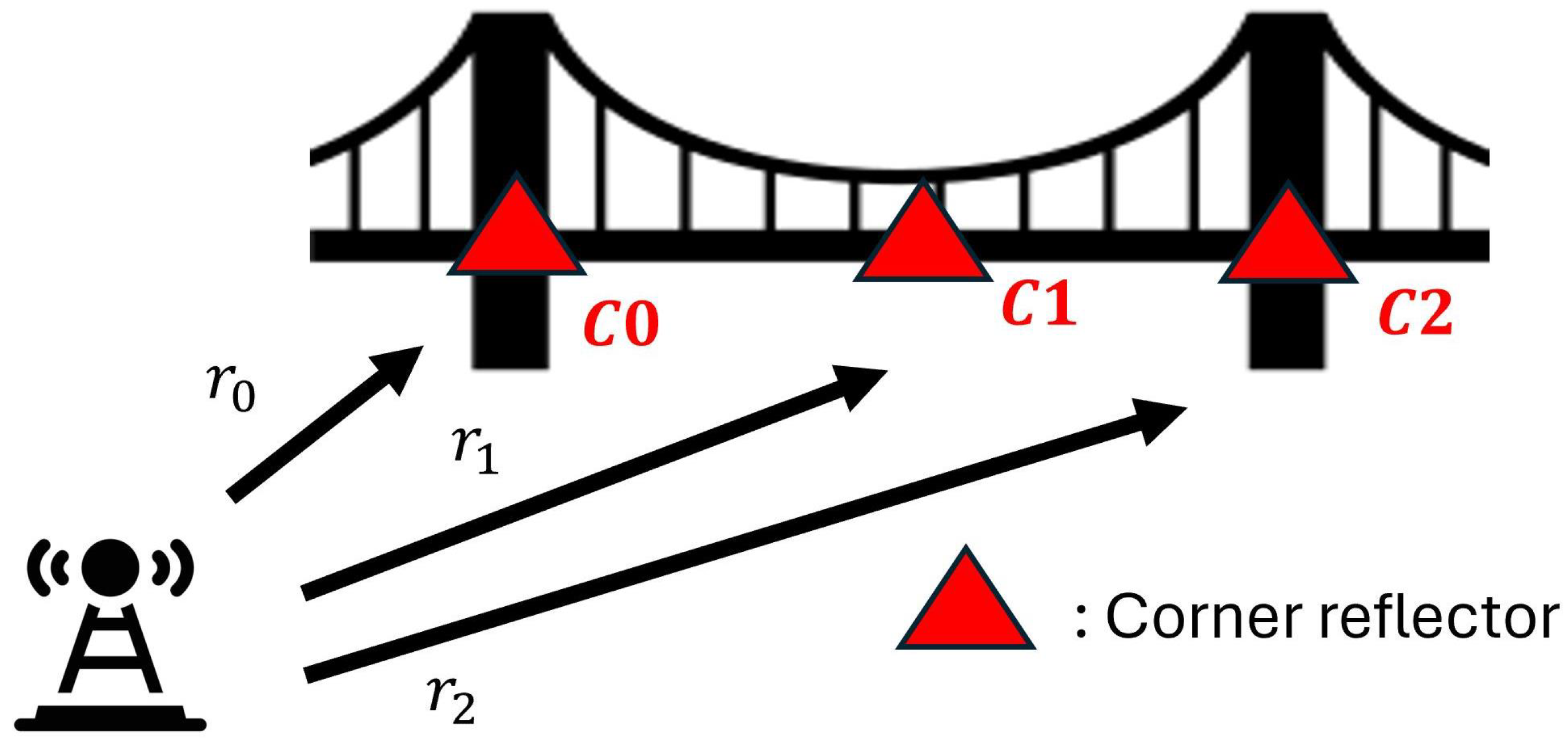
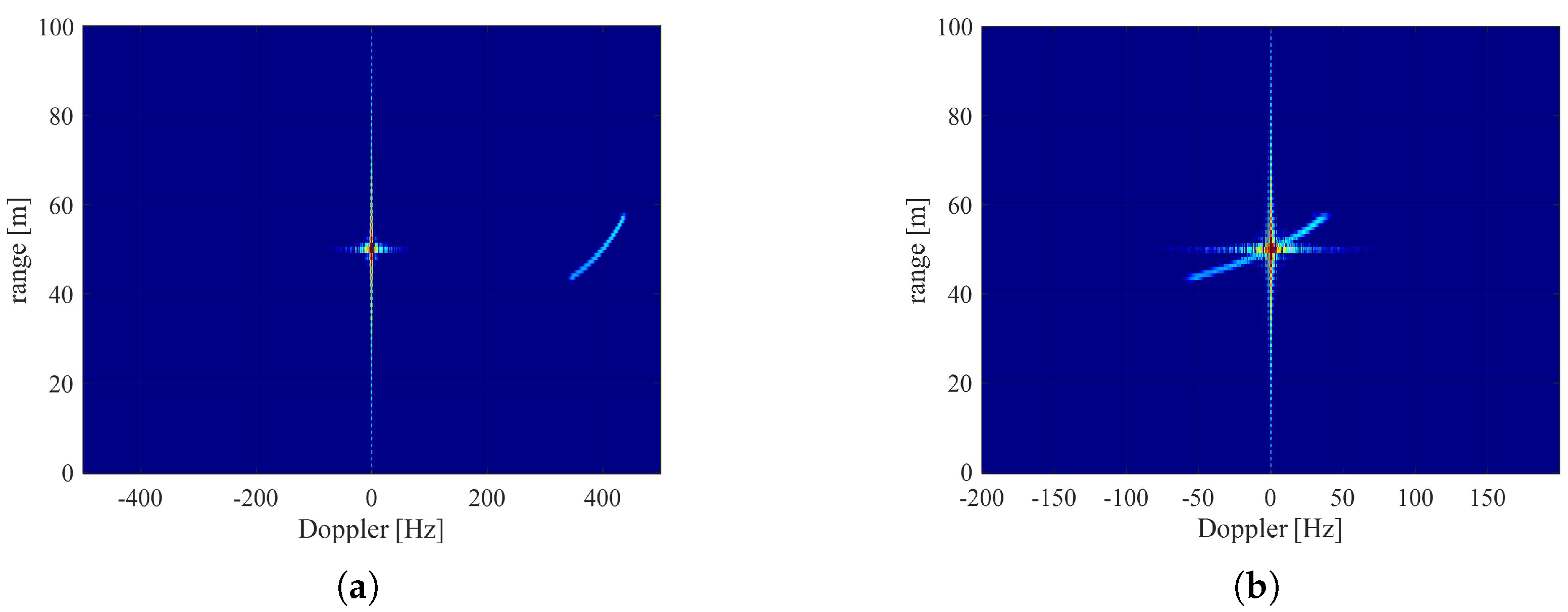


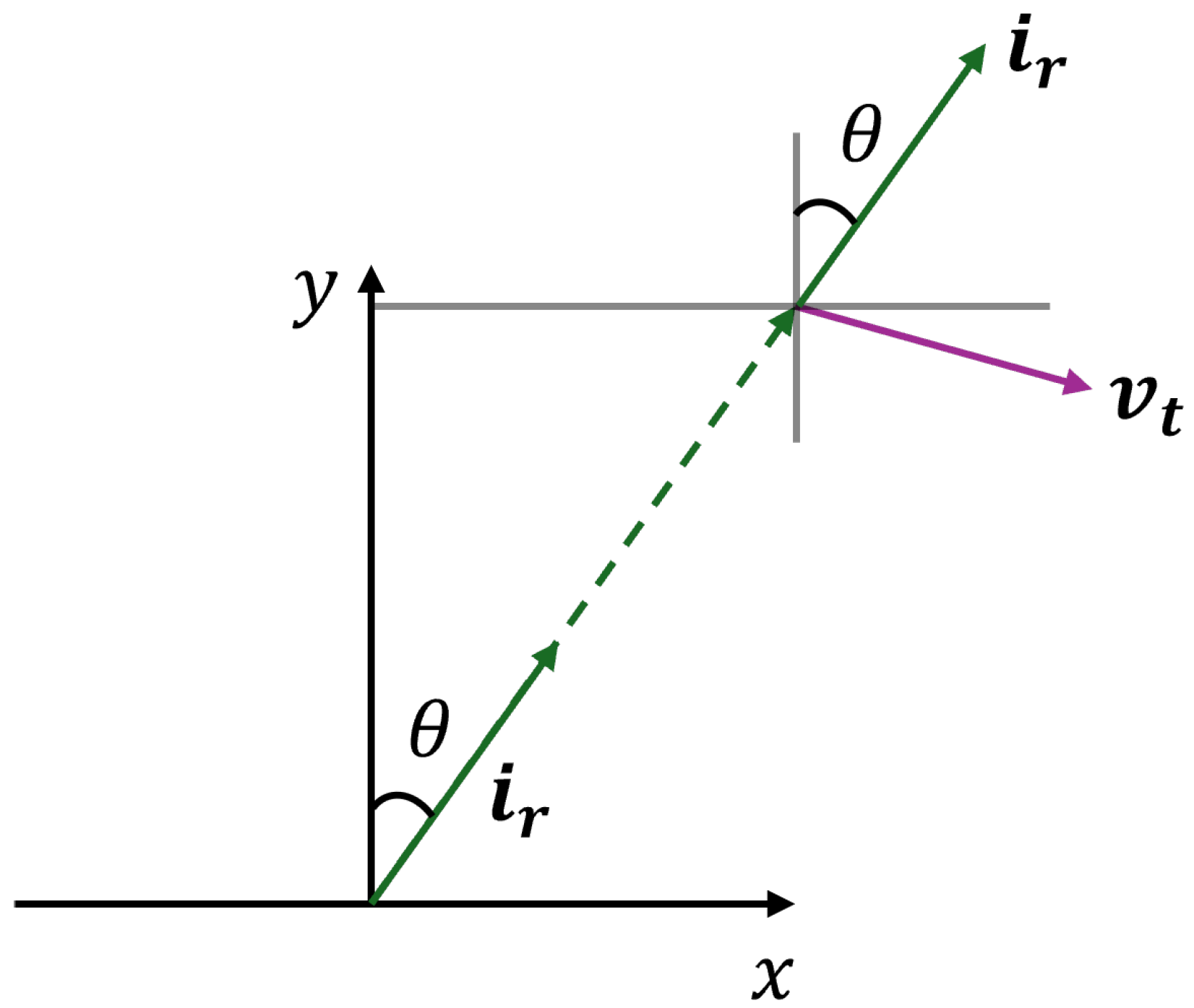
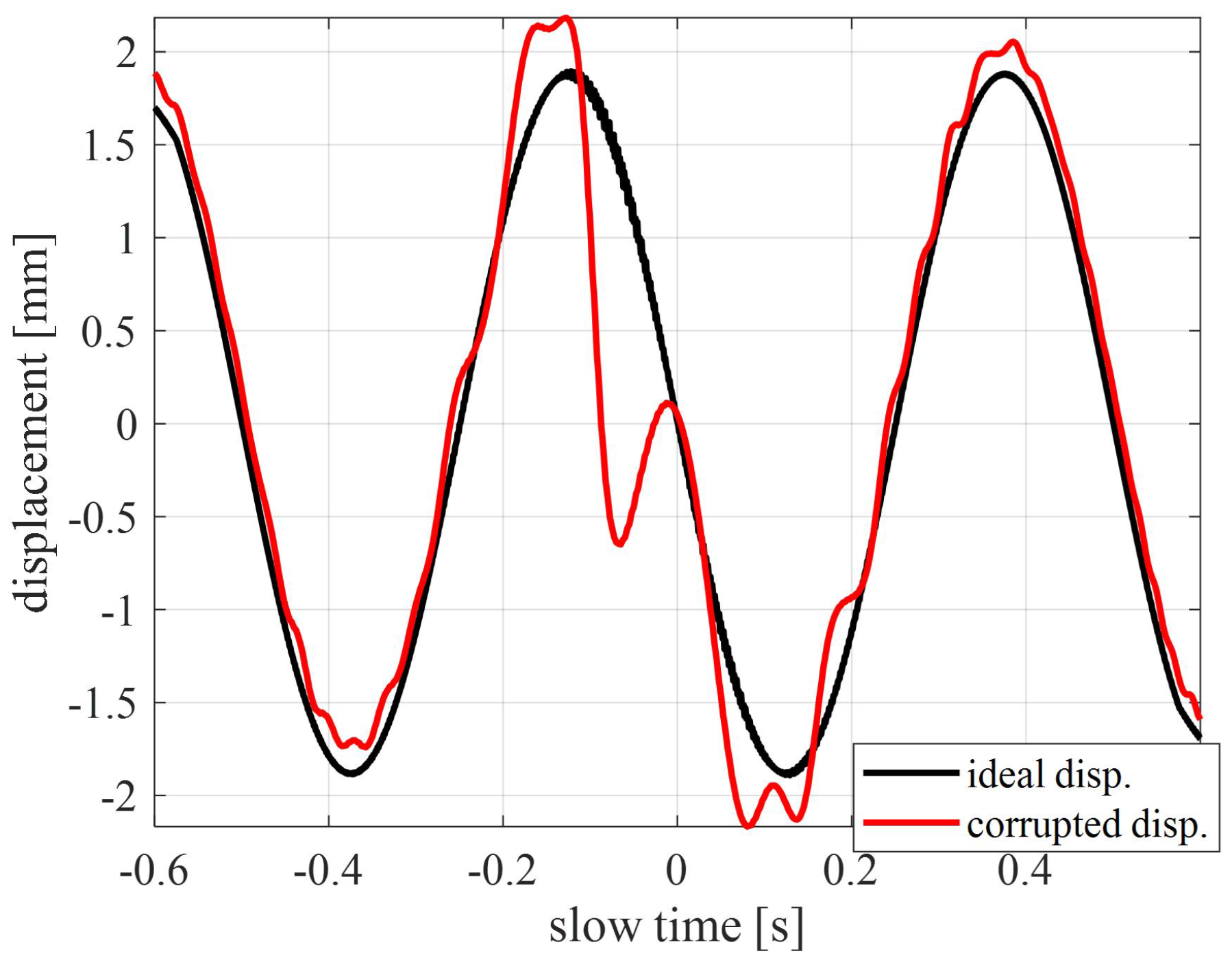
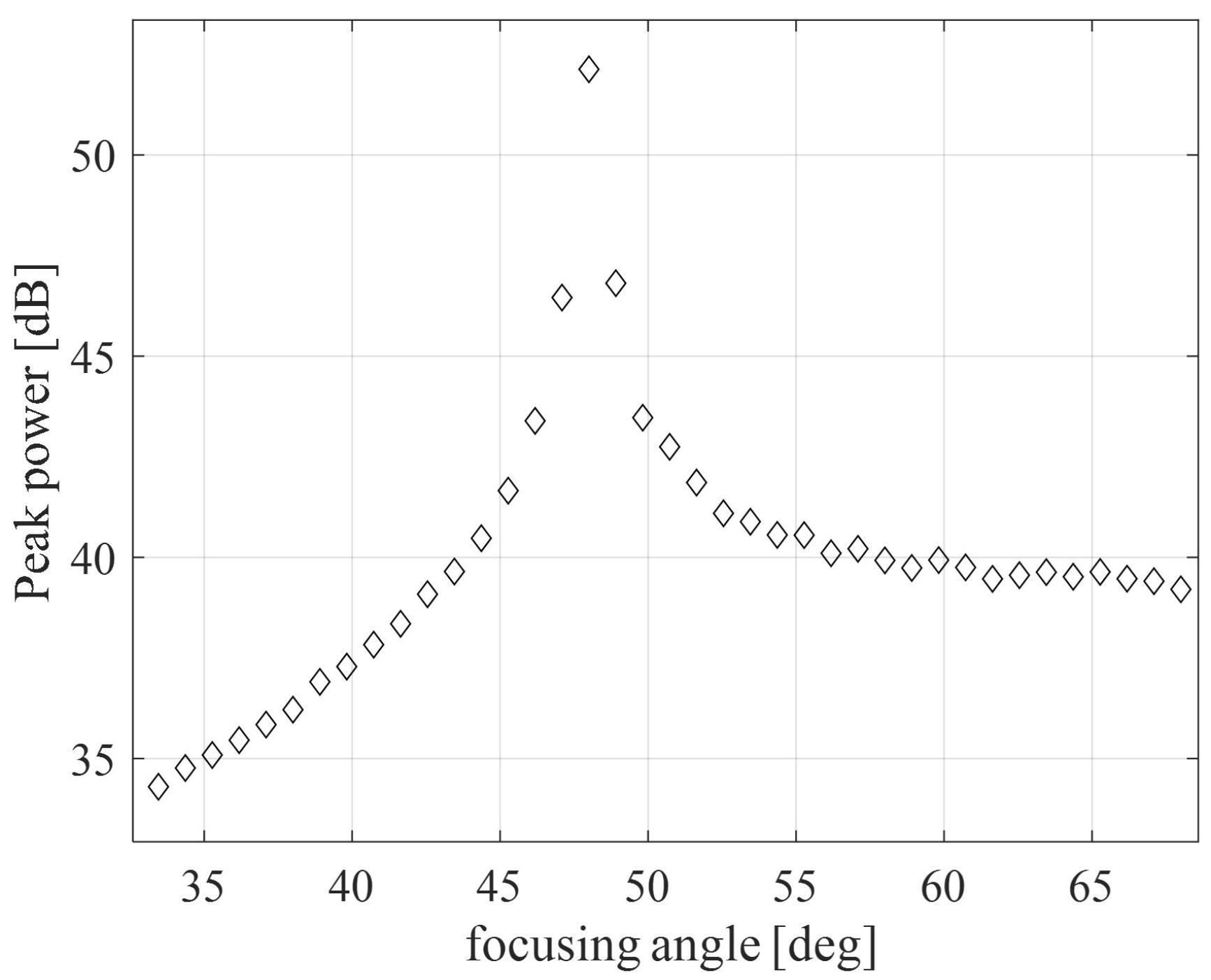


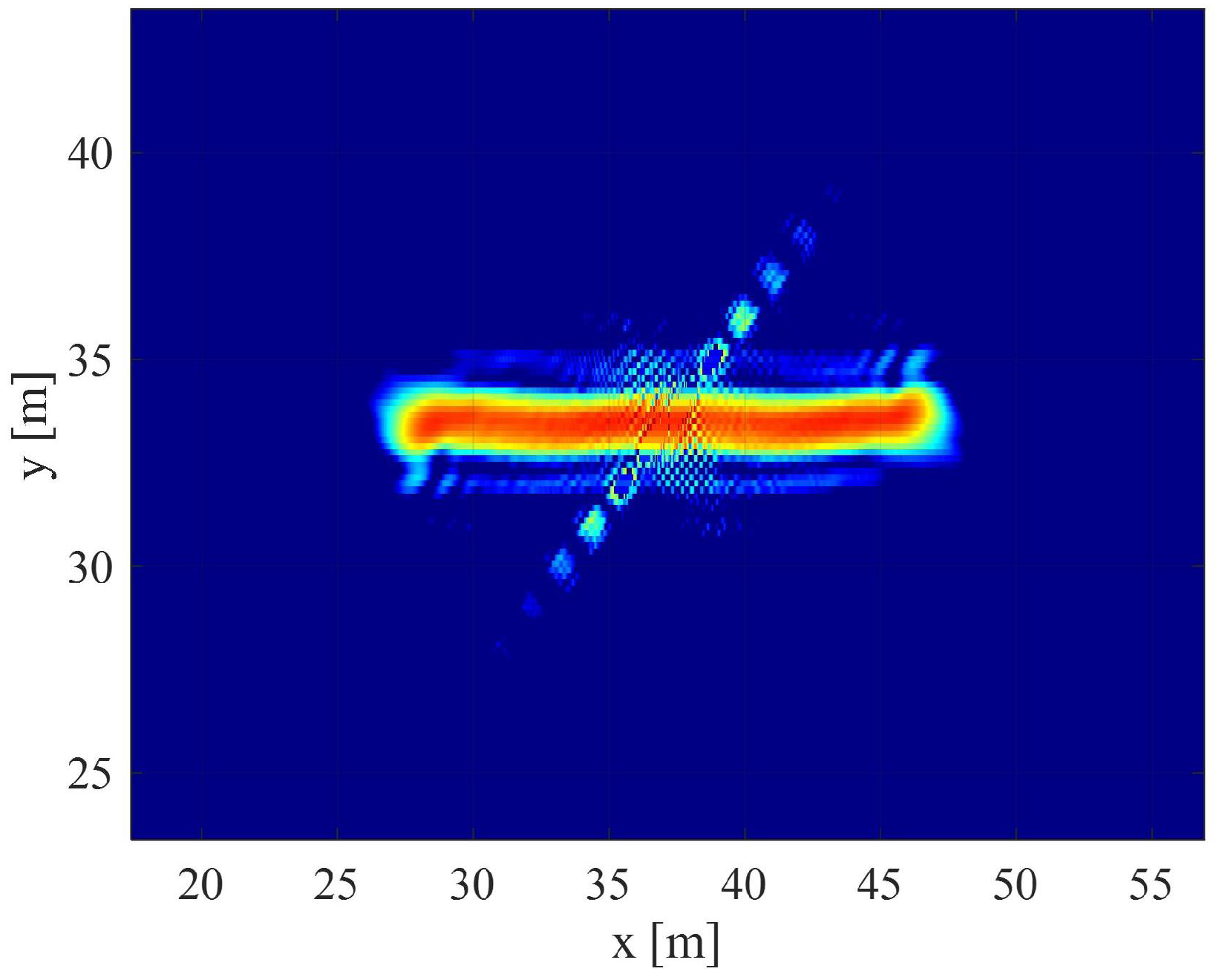
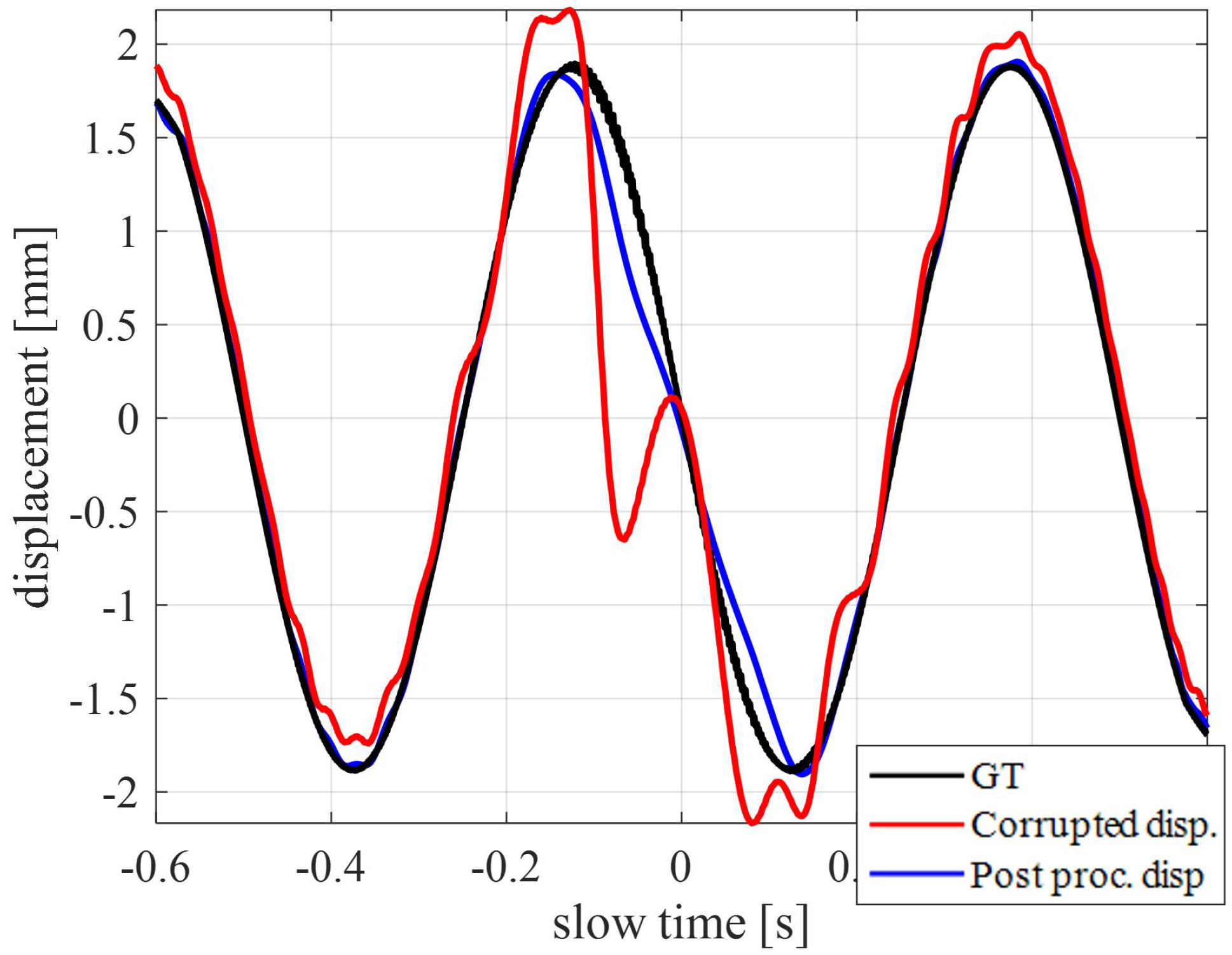



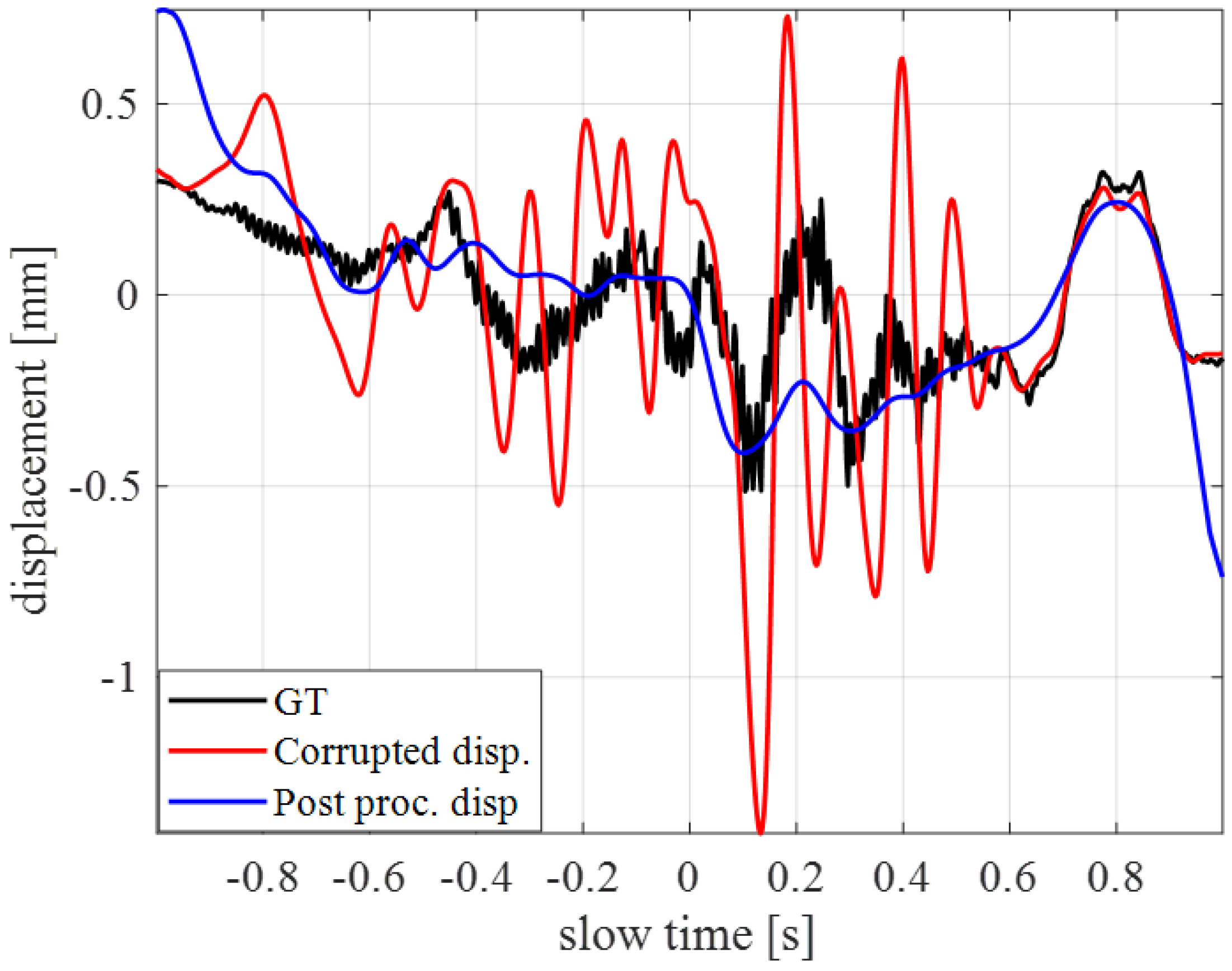
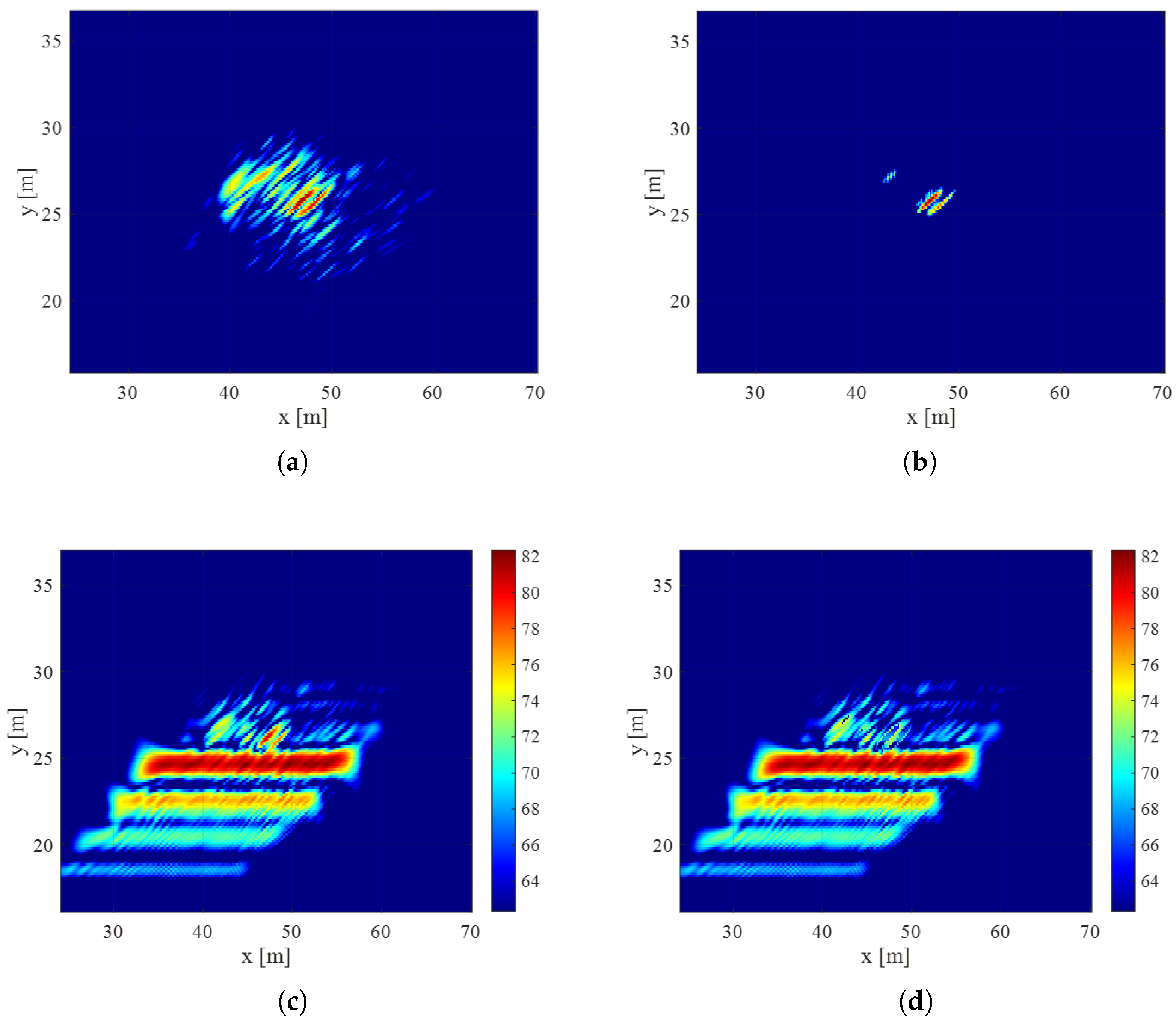

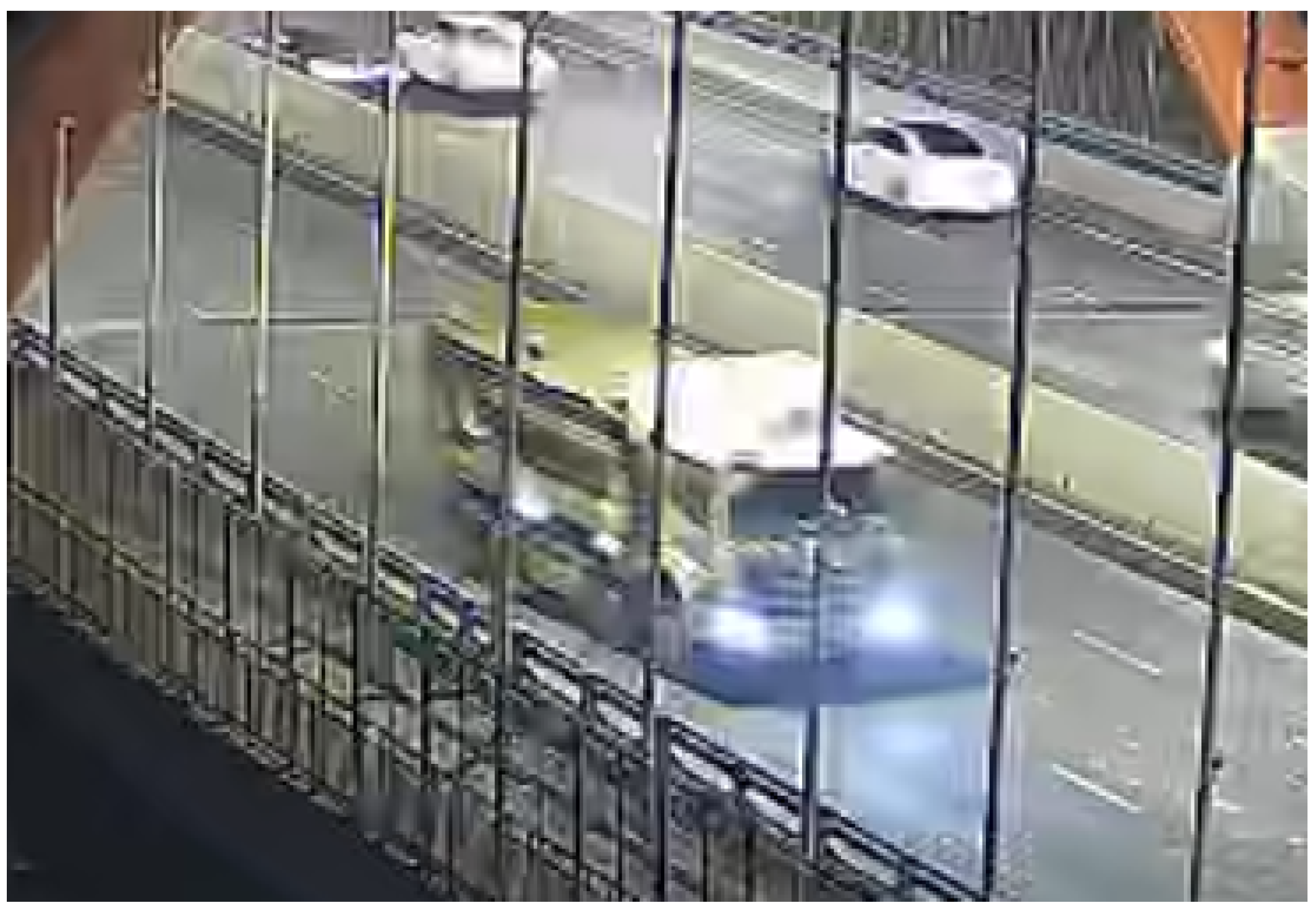
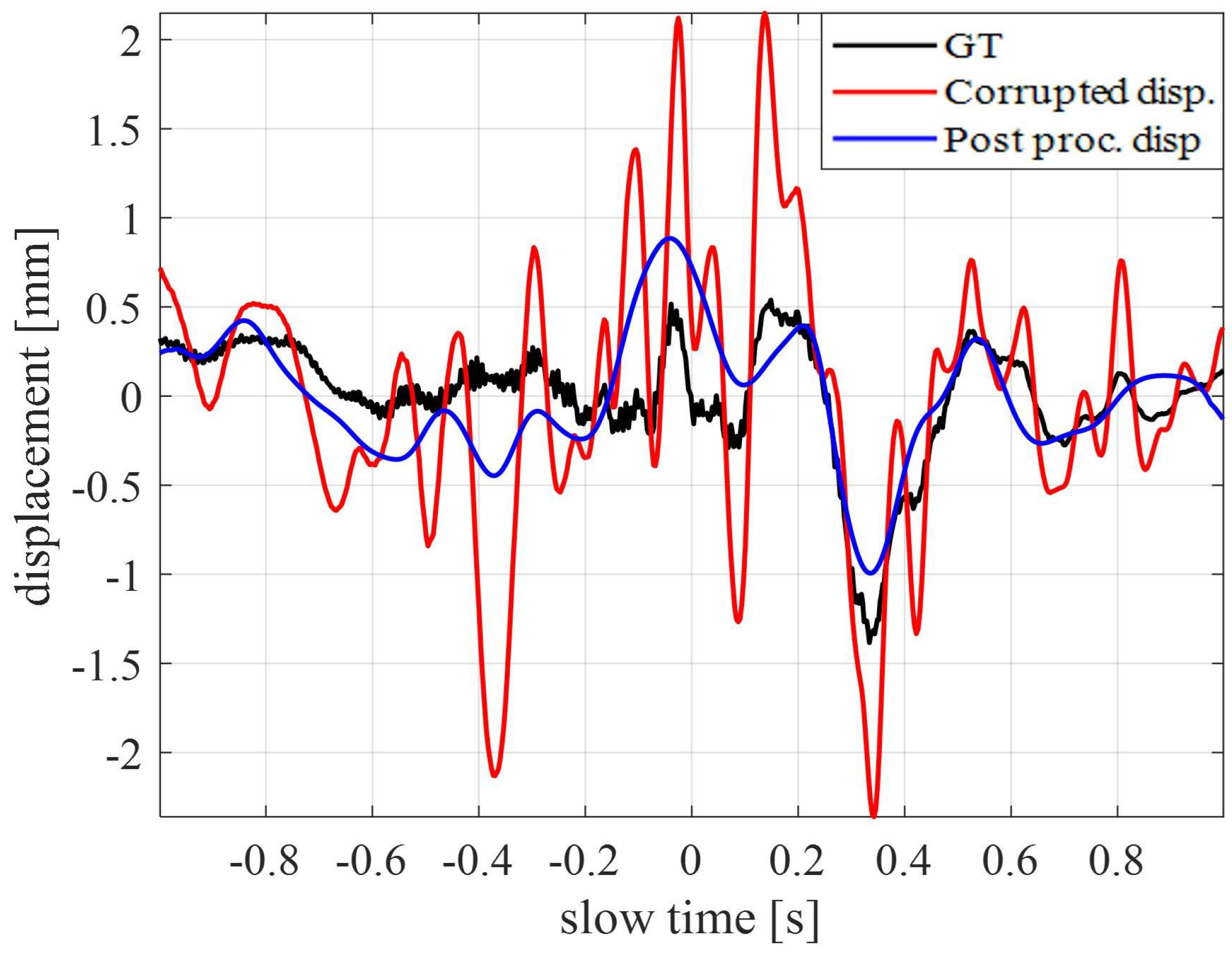

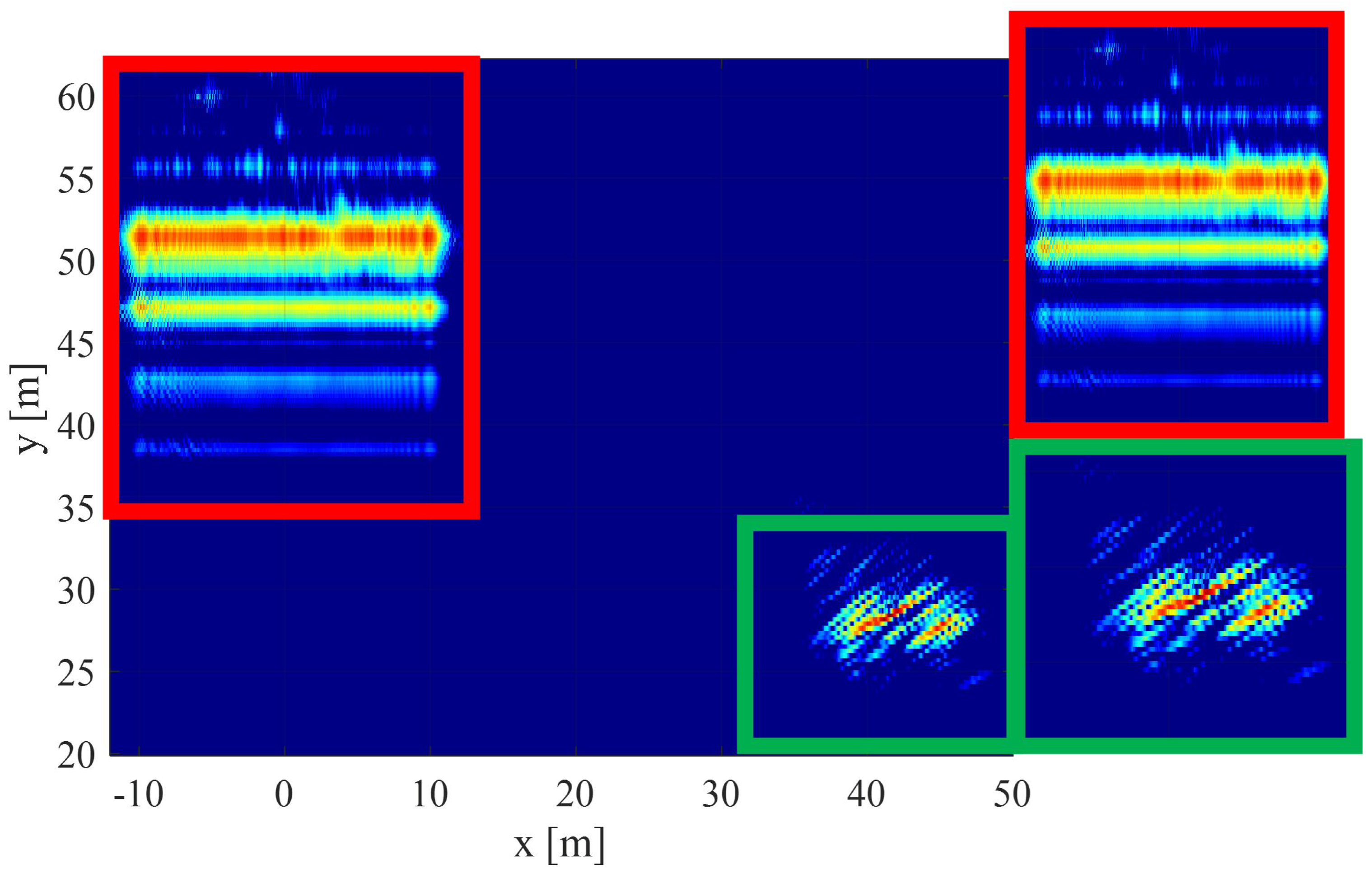


Disclaimer/Publisher’s Note: The statements, opinions and data contained in all publications are solely those of the individual author(s) and contributor(s) and not of MDPI and/or the editor(s). MDPI and/or the editor(s) disclaim responsibility for any injury to people or property resulting from any ideas, methods, instructions or products referred to in the content. |
© 2025 by the authors. Licensee MDPI, Basel, Switzerland. This article is an open access article distributed under the terms and conditions of the Creative Commons Attribution (CC BY) license (https://creativecommons.org/licenses/by/4.0/).
Share and Cite
Polisano, M.G.; Manzoni, M.; Tebaldini, S.; Badini, D.; Duque, S. Coherent Dynamic Clutter Suppression in Structural Health Monitoring via the Image Plane Technique. Remote Sens. 2025, 17, 3459. https://doi.org/10.3390/rs17203459
Polisano MG, Manzoni M, Tebaldini S, Badini D, Duque S. Coherent Dynamic Clutter Suppression in Structural Health Monitoring via the Image Plane Technique. Remote Sensing. 2025; 17(20):3459. https://doi.org/10.3390/rs17203459
Chicago/Turabian StylePolisano, Mattia Giovanni, Marco Manzoni, Stefano Tebaldini, Damiano Badini, and Sergi Duque. 2025. "Coherent Dynamic Clutter Suppression in Structural Health Monitoring via the Image Plane Technique" Remote Sensing 17, no. 20: 3459. https://doi.org/10.3390/rs17203459
APA StylePolisano, M. G., Manzoni, M., Tebaldini, S., Badini, D., & Duque, S. (2025). Coherent Dynamic Clutter Suppression in Structural Health Monitoring via the Image Plane Technique. Remote Sensing, 17(20), 3459. https://doi.org/10.3390/rs17203459






